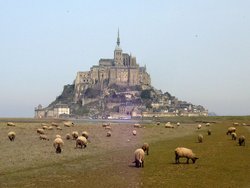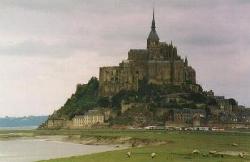Mont Saint Michel
|
|
Mont Saint Michel is a small rocky islet, roughly one kilometer from the north coast of France at the mouth of the Couesnon River, near Avranches in Normandy, close to the border of Brittany. It is home to the unusual Benedictine Abbey and steepled church (built between the 11th and 16th centuries) which occupy most of the one-kilometer-diameter clump of rocks jutting out of the waters of the English Channel.
| Contents |
Formation
Since the beginning of time the bay had been covered by the sea, which retreated during multiple glaciations, allowing erosion to shape the coastal landscape over millions of years. Several blocks of granite or granulite emerged in the bay, having resisted the wear and tear of the ocean better than the surrounding rocks. These included the Mont-Dol, Tombelaine, Lillemer and Mont Tombe, later called Mont Saint Michel.
Tidal island
The Mount is connected to the mainland via a thin natural land bridge, which before modernization was covered at high tide and revealed at low tide. Thus, Mont Saint Michel gained a mystical quality, being an island half the time, and being attached to land the other: a tidal island.
However the insular character of the mount has been compromised by several developments. Over the centuries, the coastal flats have been polderised to create pasture. The coast south of the mount has thus encroached on the distance between the shore and the mount. The Couesnon River has been canalised, reducing the flow of water and thereby encouraging a silting-up of the bay. In 1879, the land bridge was fortified into a true causeway. This prevented the tide from scouring the silt round the mount. Now there are plans to remove the causeway and replace it with a bridge and shuttle.
History
Le Mont-St-Michel was used in the 6th and 7th centuries as an Armorican stronghold of Romano-British culture and power, until it was sacked by the Franks; thus ending the trans-channel culture that had stood since the departure of the Romans in 459 AD.
Before the construction of the first monastic establishment in the 8th century, the island was called Mont Tombe. According to legend, the archangel Michael appeared to St. Aubert, bishop of Avranches, in 708 and instructed him to build a church on the rocky islet. Aubert repeatedly ignored the angel's instruction, until Michael burned a hole in the bishop's skull with his finger. The dedication to St Michael occurred on October 16, 708.
The mount gained strategic significance in 933 when the Normans annexed the Cotentin Peninsula, thereby placing the mount on the new frontier with Brittany. It is depicted in the Bayeux Tapestry, which commemorates the 1066 Norman conquest of England. Ducal and royal patronage financed the spectacular Norman architecture of the abbey in subsequent centuries.
The wealth and influence of the abbey extended to many daughter foundations, including St Michael's Mount in Cornwall, England. However, its popularity and prestige as a centre of pilgrimage waned with the Reformation and by the time of the French Revolution there were scarcely any monks in residence. The abbey was closed and converted into a prison, initially to hold clerical opponents of the republican régime. High-profile political prisoners followed, but by 1836 influential figures, including Victor Hugo, had launched a campaign to restore what was seen as a national architectural treasure. The prison was finally closed in 1863, and the mount was declared a historic monument in 1874. The Mont Saint Michel and its bay were added to the UNESCO list of World Heritage Sites in 1979.
Design
An Italian architect, William de Volpiano, was chosen as building contractor for the mount in the 11th century. He designed the roman church of the abbey, daringly placing the transept crossing at the top of the mount. Many underground crypts and chapels had to be built to compensate for this weight. These formed the basis for the supportive upward structure that can be seen today.
Robert de Thorigny, a great supporter of Henry II of England (who was also Duke of Normandy), reinforced the structure of the buildings and built the main façade of the church in the 12th century. Following his annexation of Normandy in 1204, the King of France, Philip Augustus offered abbot Jourdain a grant for the construction of a new gothic style architectural set which included the addition of the refectory and cloister.
Tides
The tides in the area shift quickly, and has been described by Victor Hugo as "à la vitesse d'un cheval au galop" or as swiftly as a galloping horse. However, this is an exaggeration, as the tide actually comes in at 1 metre per second.
The tides can vary greatly, at roughly 14 meters between high and low water marks. Popularly nicknamed St. Michael in peril of the sea by mediaeval pilgrims making their way across the tidal flats, the mount can still pose dangers for visitors who avoid the causeway and attempt the hazardous walk across the sands from the neighbouring coast. The dangers from the tides and quicksands continue to claim lives.
Administration
The islet belongs to the French commune Le Mont-Saint-Michel, of the Manche département, in the Basse-Normandie région. Population (1999): 50.
Miscellaneous
The mount is the object of traditional, but nowadays good-humoured, rivalry between Normans and Bretons. Bretons claim that, since the Couesnon River marks the traditional boundary between Normandy and Brittany, it is only because the river has altered its course over the centuries that has placed the mount on the Norman side of the frontier. Normans display a certain proprietorial pride in the mount - for example, the Manche département in which the mount is situated uses its silhouette in its logo - and affect mild irritation on occasions when Brittany uses the mount in tourist publicity.
The commune belongs to the Organization of World Heritage Cities.
The 1990 Fritjof Capra film Mindwalk was filmed on the mount.
British electronic music artist Aphex Twin released a song entitled Mt. Saint Michel Mix+St. Michaels Mount, which was reportedly produced on his travels in both of these locations.
Feudal Era Japanese samurai Samanosuke Akechi visited Mont Saint Michel in the video game Onimusha 3: Demon Siege.
See also
External links
- Website about the Mont Saint Michel (http://www.monum.fr/m_stmichel/indexa.dml?lang=en)
- Website about the abbey : History, Visit, Chronology... (http://www.abbayedumontsaintmichel.net)
- Website about the Mount in French (http://www.asteria.fr/cadre.htm)af:Mont-Saint-Michel
de:Mont-Saint-Michel fr:Mont Saint-Michel it:Mont Saint Michel ja:モン・サン・ミッシェル nl:Mont Saint Michel pt:Mont Saint-Michel ru:Мон-Cэн-Мишель sl:Mont Saint Michel


